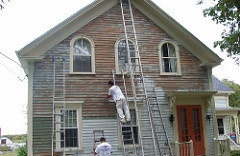 With any home task, there's the proper way, and then there's the easy way. Never, it seems, shall the twain ever meet. This is particularly true of painting, a task I abhor. I have read a few DIY Painting Hacks articles sharing the correct way to paint a house, and it’s all good advice. While the information encompasses all the best ways to accomplish this kind of project, sometimes there are worthwhile alternative short-cuts.
With any home task, there's the proper way, and then there's the easy way. Never, it seems, shall the twain ever meet. This is particularly true of painting, a task I abhor. I have read a few DIY Painting Hacks articles sharing the correct way to paint a house, and it’s all good advice. While the information encompasses all the best ways to accomplish this kind of project, sometimes there are worthwhile alternative short-cuts.
None of the guidance below will be lauded by professional house painters. It's quick and dirty and has flaws (which I disclose at the end). But it serves a particular purpose and will get your house painted if you face any of the same challenges.
Using the same color or darker renders it easier to lay down just one coat.
You generate more work for yourself when you elect to alter your exterior house color, and it dramatically escalates the amount of work required when you proceed with a lighter color.
When using a one-coat-paint approach, the previous color may still show through in some areas. When you paint with the same color, though, those thinner areas blend in.
- Not sure of the present color? Find peeling paint, pull it off, and bring it to a paint store. They can match it. Dedicated paint stores like Sherwin-Williams usually do a more effective job of this than home improvement stores.
- Want to alter the color? Then make the next color darker than the existing one.
Clean house, but don't labor endlessly over this.
It's hard to picture a house that doesn't need to be thoroughly washed down before painting. Just pass a white cloth over the side of your house to see the volume of gray soot and dust that has gathered over the years. Even for the lightest of painting projects, I would still recommend washing down the house.
Doing this by hand is the most work demanding end of the spectrum, so what's the least you can do? Use a pressure washer and wash the surface once with the cleaning solution and once again with clean water. No pressure washer? Just hose it down. Even that's better than no cleaning at all. Your two goals:
Address spots of unpainted and unprimed areas with primer, not the entire house.
While the overall house may benefit from a full coat of primer, you should prime only the problem areas, meaning areas with raw wood and dried wood filler.
If you only have bare spots (instead of entire bare sections), a quart of primer will be plenty. Brush it on, and you're done.

Prep time can kill your motivation. Don't do any more than you need to.
Getting ready to paint can equal the length of time spent actually painting. Taping and covering will quash the eagerness of even the most persistent homeowner. Doing a meticulous job on a house with numerous elements can consume an entire day's effort, maybe more.
Scrape until you get to a relatively solid edge.
Scraping paint isn't such a time-waster by itself. You’ll find the challenge resembles opening a Pandora's Box. You begin with scraping that small dime-sized flake of paint, and before you realize, it leads to more and more.
As a general rule, if the edges of the paint stay down, let it be. The new paint will seal the edges and keep it down. It's not a perfect seal and probably never will be, but it will hold for awhile.
If you have flat siding, use a roller and pole.
Rolling is a real time saver when your paint landscape allows it. You can deal with vast areas of siding quickly, and the paint goes down thick. As a result, it usually doesn't call for an entire day's commitment. You can invest 45 minutes or so on your project, toss the roller cover, and be back at more important endeavors, like surfing the Internet, watching TV, or having fun with the kids.
The potential drawback is that many kinds of siding don't readily lend themselves to rolling.
Large areas of your house with few or no features-- doors, windows, lights, downspouts, cable boxes, etc., can be time-efficiently painted with a sprayer.
In many cases using a sprayer would appear to be the clear winner. However, spraying necessitates an enormous amount of preparation. You'll need to protect every single square inch of non-paintable surface within 20 feet of the project. Once you get started though, spraying is incredibly fast. Besides the prep time, another negative aspect of spraying is that you can only lay down a thin coat.
If your project shares the side of the house has grass instead of pavement, so much the better. You’ll be able to spray without putting down a drop cloth. Yes, the grass may catch a bit of overspray, but the next couple of mowings should eliminate it.
- For exterior painting, buy inexpensive roller covers and toss them as you finish each painting session. Better quality covers are highly recommended for interior painting, where critical eyes will have a close-up view of your work. Exterior painting is much more forgiving.
- For little touch-ups of incidental smears, you can get by with foam brushes or cheap $0.99 nylon brushes. Toss these when you’re done.
- Be sure to clean your good brushes with a paint brush comb and water. Combs cut brush clean-up time at least by half and will do a much better job of keeping your brushes ready for the next task; highly recommended.
Bottom line, if you’re doing the painting on your own, there are several things you can do to make your job easier. However, you’ll find the most effective method of achieving the picture-perfect results you imagine when planning your project is to let the professionals at Fantastic Finishes Paint Co. do the work for you!

ABOUT FANTASTIC FINISHES PAINT CO.
Our contractors are fully bonded and insured with
the expertise to perform whatever task you may
require, efficiently and with customer satisfaction
as their first priority.
Contact us today for a free estimate! (972) 672-2512
Web Design, Hosting, and Online Marketing Provided By 2Surge Marketing